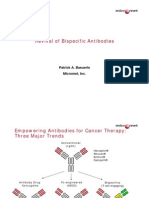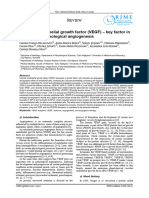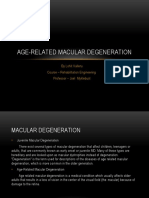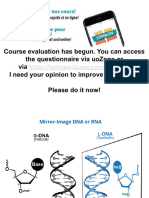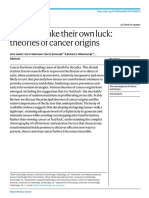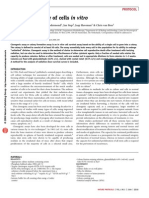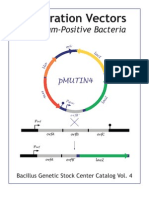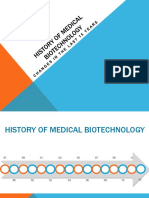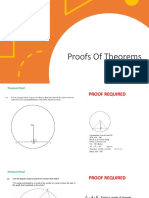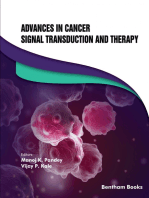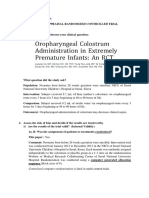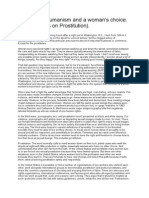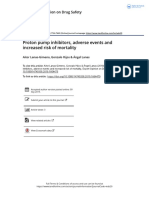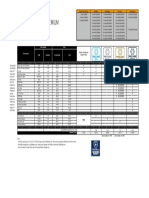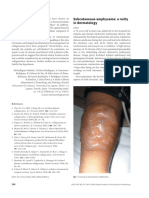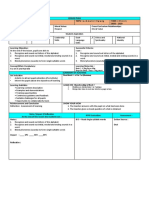Angiogenesis in Cancer
Angiogenesis in Cancer
Uploaded by
Aisya FikritamaCopyright:
Available Formats
Angiogenesis in Cancer
Angiogenesis in Cancer
Uploaded by
Aisya FikritamaOriginal Description:
Copyright
Available Formats
Share this document
Did you find this document useful?
Is this content inappropriate?
Copyright:
Available Formats
Angiogenesis in Cancer
Angiogenesis in Cancer
Uploaded by
Aisya FikritamaCopyright:
Available Formats
Langenbecks Arch Surg (2007) 392:371379
DOI 10.1007/s00423-007-0150-0
NEW SURGICAL HORIZONS
Angiogenesis in cancer: molecular mechanisms,
clinical impact
M. E. Eichhorn & A. Kleespies & M. K. Angele &
K.-W. Jauch & C. J. Bruns
Received: 30 November 2006 / Accepted: 1 December 2006 / Published online: 16 February 2007
# Springer-Verlag 2007
Abstract
Background Angiogenesis, the formation of new blood
vessels from the endothelium of the existing vasculature, is
fundamental in tumor growth, progression, and metastasis.
Inhibiting tumor angiogenesis is a promising strategy for
treatment of cancer and has been successfully transferred
from preclinical to clinical application in recent years.
Whereas conventional therapeutic approaches, e.g. chemotherapy and radiation, are focussing on tumor cells,
antiangiogenic therapy is directed against the tumor
supplying blood vessels.
Materials and methods This review will summarize important molecular mechanisms of tumor angiogenesis and
advances in the design of antiangiogenic drugs. Furthermore, clinical implications of antiangiogenic therapy in
surgical oncology will be discussed.
Results First antiangiogenic drugs have been approved for
treatment of advanced solid tumors in several countries.
Leading antiangiogenic drugs are designed to inhibit
vascular endothelial growth factor-mediated tumor angiogenesis. Combining antiangiogenic agents with conventional chemotherapy or radiation is currently investigated
clinically with great emphasis to realize a multimodal
M. E. Eichhorn : A. Kleespies : M. K. Angele : K.-W. Jauch :
C. J. Bruns (*)
Department of Surgery, Klinikum Grosshadern,
University of Munich,
Marchioninistr. 15,
80337 Munich, Germany
e-mail: Christiane.Bruns@med.uni-muenchen.de
M. E. Eichhorn
Institute for Surgical Research, Klinikum Grosshadern,
University of Munich,
Munich, Germany
tumor therapy, targeting both the tumor cell and tumor
vascular compartment.
Conclusion Antiangiogenic tumor therapy represents a
promising strategy for treatment of cancer and will most
likely exhibit its clinical potential in combination with
established standard tumor therapies in the future.
Keywords Angiogenesis . Antiangiogenic therapy . Tumor .
VEGF
Introduction
Angiogenesis, the formation of new blood vessels from the
endothelium of the existing vasculature, is fundamental in
tumor growth, progression and metastasis [1]. The complex
network of tumor blood microvessels guarantees adequate
supply of tumor cells with nutrients and oxygen and
provides efficient drainage of metabolites. In 1945, Algire
and Chalkley [2] were the first to conclude that the growth
of a solid tumor is closely connected to the development of
an intrinsic vascular network. In addition to primary tumor
growth, metastatic tumor growth depends upon neovascularization in at least two steps: First, malignant cells must
exit from a primary tumor into the blood circulation after
the tumor becomes neovascularized. Second, after arrival at
distant organs, metastatic cells must again induce angiogenesis for a tumor to expand to a detectable size. In the
1970s, the surgeon Folkman [3] was the first to hypothesize
that targeting the blood supply by inhibiting blood vessel
formation will lead to arrest of tumor growth or even tumor
shrinkage. The physiologic basis of this hypothesis is that
tumors cannot exceed 12 mm3 in an avascular state.
Thereafter, an intensive and successful research on molecular mechanisms of tumor angiogenesis was started. Over
372
the last 30 years, numerous pro- and antiangiogenic
molecules, their ligands, and intracellular signalling pathways have been identified. Enormous efforts have been
undertaken to develop antiangiogenic strategies for clinical
cancer treatment. Despite numerous promising results in
preclinical models, several initial clinical trials gave no
convincing evidence for efficient antitumoral therapy by
classical antiangiogenic agents as monotherapy. This has
led to the development of new antiangiogenic compounds
and successful combination of angiogenesis inhibitors with
classical cytotoxic chemotherapy and radiotherapy. Combined with chemotherapy, antiangiogenesis has proven its
clinical efficiency in patients suffering from advanced
colorectal cancer leading to an improved patient survival
time [4]. In 2004, the first antiangiogenic compound
bevacizumab (Avastin) was therefore approved by the Food
and Drug Administration (FDA) as first-line therapy in
combination with standard 5-fluorouracil-based chemotherapy in patients with advanced colorectal cancer.
In this review, we will outline pathophysiological and
molecular mechanism of tumor angiogenesis, and we will
focus on the clinical impact of recently developed antiangiogenic therapies.
Mechanisms of angiogenesis in cancer
Once a neoplastic mutation has occurred, an avascular
phase of tumor growth follows. Tumor cells are supplied by
diffusion, and tumor growth is arrested at a size of 1
2 mm3. The following stadium of tumor dormancy can
last up to years [5]. Today, the theory of an angiogenic
switch, controlled by the balance between pro- and
antiangiogenic molecules in the solid tumor microenvironment, is accepted [6] (Fig. 1). The switch clearly involves
more than simple upregulation of angiogenic activity and is
thought to be the result of a net balance of positive and
negative regulators [6]. When proangiogenic factors overcome the effect of angiostatic molecules, the tumor acquires
an angiogenic phenotype that leads to the formation of new
blood vessels. Endothelial progenitor cells, the cross talk
between angiogenic factors and their receptors and the
interaction between vasculogenesis and lymphangiogenesis
Langenbecks Arch Surg (2007) 392:371379
are all factors that may contribute to the switch [7]. The
acquisition of the angiogenic phenotype is considered to be
a key step in early tumor progression, which allows the
tumor to transform from a microscopic lesion to a rapidly
expanding mass with metastatic thread. Oncogene-derived
protein expression as well as a number of cellular stress
factors, such as hypoxia, low pH, nutrient deprivation, or
inducers of reactive oxygen species, are important stimuli
of angiogenic signaling [6]. An important extension of the
angiogenic switch model is that the switch may be tripped
in the angiostatic direction at the site of a primary tumor but
in the opposite angiogenic direction at the site of distant
metastases. In the surgical treatment of certain solid tumors,
a growth of metastatic tumors following removal of a large
primary tumor has been observed [8].
Several sequential steps can be highlighted during tumor
angiogenesis. In mature, nongrowing capillaries, the vessel
wall is composed of an endothelial cell lining, a basement
membrane, and a pericyte coverage. Angiogenic factors
produced by tumor cells bind to endothelial cell receptors
and initiate the sequence of angiogenesis. Angiogenesis is
the result of a highly orchestrated series of molecular and
cellular events, resulting in the migration, proliferation, and
differentiation of endothelial cells into newly formed
capillaries that can subsequently develop into more mature
vessels. The angiogenic cascade includes both an activation
and resolution phase. When the endothelial cells are
stimulated to grow, they secrete proteases, heparanase, and
other digestive enzymes that digest the basement membrane
surrounding the vessel. The dissolution of the extracellular
matrix allows the release of proangiogenic factors from the
matrix. The junctions between endothelial cells become
leaky, and newly formed vessel sprouts grow toward the
source of the stimulus. Besides further endothelial cell
proliferation and migration, hematopoetic endothelial progenitor cells are also considered to contribute to capillary
lumen formation. Resolution then results in the maturation
and stabilization of the newly formed microvasculature by
investment of vessels with pericytes, basement membrane
reconstruction, and junctional complex formation. Within
the tumor vascular network, the resolution phase is incomplete, resulting in microvessels that are irregular and tortuous
(Fig. 2), with partial endothelial linings and fragmentary
basement membrane as well as increased microvascular
permeability. Tumor vessels tend to break conventional
rules of microcirculation, spreading without organization
and changing vessel diameters with missing differentiation
in arterioles, capillaries, and venules.
Proangiogenic factors
Fig. 1 Exemplified pro- and antiangiogenic molecules balancing the
angiogenic switch
Cancer cells are capable of stimulating angiogenesis by
producing several angiogenic factors, which include vas-
Langenbecks Arch Surg (2007) 392:371379
373
Fig. 2 Tumor angiogenesis investigated in vivo in the dorsal
skinfold chamber model of
Syrian golden hamsters. a Macroscopic view of the amelanotic
melanoma A-Mel-3 grown for
10 days depicting a well-established tumor vascular network.
Intravital microscopy (b) shows
the typical chaotic tumor microcirculation with sprout formation, spiraling and changing
vessel diameters
cular endothelial-derived growth factor (VEGF), angiopoetins, basic fibroblast-like growth factor (bFGF), epidermal
growth factor (EGF), interleukin 8 (IL-8), and transforming
growth factor (TGF-) besides numerous other molecules
(Fig. 1). In addition to tumor cells, tumor endothelial cells,
stroma cells, and circulating host cells (endothelial progenitor cells, platelets, and macrophages) are capable in
secreting modulators of angiogenesis [7]. Blood platelets
for instance have been proposed to contribute to angiogenesis by release of potent proangiogenic molecules from
their -granules [9, 10]. Platelets carry a large pool of
mediators, such as VEGF-A, platelet-derived growth factor
(PDGF), and bFGF. Moreover, hepatocyte growth factor,
EGF, angiopoetin-1, fibronection, and heparanase secreted
after platelet activation can further stimulate tumor
angiogenesis.
Vascular endothelial growth factor One of the molecules
that play a pivotal role in tumor angiogenesis is VEGF, one
of the most potent angiogenic cytokines discovered and
cloned by Napoleone Ferrara in 1989 [11]. It has first been
characterized for its ability to induce vascular leakage and
is therefore also known as vascular permeability factor.
Today, six known members of the VEGF family have been
discovered: VEGF-A, -B, -C, -D, and -E and the placental
growth factor [12]. VEGF-A is mainly involved in
angiogenesis, whereas VEGF-C and VEGF-D are involved
in lymphangiogenesis. The VEGF family activates endothelial cells by signaling through the VEGF receptors
(VEGFR-1, -2, -3) [12] (Fig. 3). VEGFR-1 (fms-like tyrosine kinase receptor, Flt-1) and VEGFR-2 (kinase insert
domain containing receptor, KDR) are located on vascular
endothelium and are upregulated during angiogenesis,
whereas VEGFR-3 is expressed on lymphatics. The angiogenic effects are primarily exerted through the binding of
VEGF-A to VEGFR-2. VEGFR-2 undergoes dimerization
and ligand-dependent tyrosine phosphorylation in intact
endothelial cells and results in a mitogenic, chemotactic,
and prosurvival signal. VEGF-C binds to VEGFR-3 and is
mitogenic to lymphatic endothelial cells and induces
hyperplasia of preexisting lymphatic vessels. VEGF pro-
duction is upregulated by several major growth factors that
are frequently expressed by tumors, including EGF, TGF-
and -, FGF, and PDGF. Hormones, such as estrogen and
thyroid-stimulating hormone, and inflammatory cytokines,
including IL-1 and IL-6, also induce VEGF expression in
many cell types. It cannot be excluded that VEGF has an
action on tumor cells directly, by inhibiting interaction of
VEGF with non-tyrosine kinase neuropilin receptors, coreceptors of VEGF that influence cell mitogenesis [13].
Angiopoetins The angiopoetins (Ang-1Ang-4) have been
implicated in the development of vasculature in a wide
variety of tumor types [14]. Among the four known
angiopoetins, Ang-1 and Ang-2 are the best characterized
cytokines, both exerting their biologic function through
binding to the Tie-2 receptor [15]. Ang-1 promotes
endothelial cell survival and sprouting and stabilizes
vascular networks by recruiting pericytes to immature
vessel segments. In contrast, Ang-2, expressed at sites of
vascular remodeling, causes the loss of pericytes and
exposes endothelial cells to angiogenic factors. In the
presence of VEGF, this destabilization induces an angiogenic response. The expression of Ang-1 tends to be
restricted to the tumor cells, whereas Ang-2 is also seen
in the microvasculature. In many cases, the level of Ang-1
expressed by tumor cells remains unaltered, whereas the
expression of Ang-2 is seen to be increased particularly in
highly vascularized tumors.
Fibroblast growth factors FGFs are a family of heparinbinding proteins. FGF-1 (acidic) and FGF-2 (basic) are
described as inductors of angiogenesis [16]. All FGFs bind
to heparin sulphateproteoglycans (HLGAGs) of the extracellular matrix (ECM). FGFs can bind to four transmembrane-specific receptor tyrosine kinases inducing receptor
dimerization and activation. FGF-1 and FGF-2 induce
endothelial cell proliferation and differentiation of epiblast
cells into endothelial cells. Furthermore, FGF-2 stimulates
the release of urinary plaminogen activator and collagenases in endothelial cells and acts as a chemo-attractant for
these cells.
374
Antiangiogenic factors
The presence of angiogenic factors is not enough to initiate
the new vascular growth. Proangiogenic factors are counterbalanced by a number of natural antiangiogenic molecules
summarized in Fig. 1. In this review, we would like to
exemplify the antiangiogenic factors thrombospondin-1
(TSP-1) and angiostatin/endostatin.
Thrombospondin-1 Thrombospondins belong to a family of
ECM proteins. CD36 (also known as GP88, GP IV, GP
IIIb) is an important cellular receptor for TSP-1 on
microvascular endothelium and is necessary for its antiangiogenic activity [17]. The antiangiogenic activity of
TSP-1 is contained in a structural domain known as the
TSP type I repeat. The interaction between TSP-1 and its
receptor activates a sequence of intracellular events finally
resulting in endothelial cell apoptosis [18]. In addition to
CD36-mediated antiangiogenic effects, TSP-1 can potentially inhibit angiogenesis through an interaction with proMMP2/9, MMP-2/9 or induction of cell cycle arrest.
However, different studies report a controversial role of
TSP-1 on angiogenesis depending on the functional status
of TSP-1 domains/fragments. Several proteolytic enzymes,
including thrombin, plasmin, and trypsin, generate two
fragments of TSP-1 of 25 and 140 kDa. Although most of
the antiangiogenic activity mediated via the CD36 receptor
is located in the 140-kDa fragment, a positive effect on
angiogenesis has been detected on the 25-kDa heparinbinding fragment of TSP-1.
Endostatin/angiostatin Angiostatin is a 38-kDa plasminogen fragment. Systemic injection of angiostatin has been
shown to inhibit tumor neovascularization and metastitic
growth. Angiostatin functions as an inhibitor of ECMenhanced and t-PA catalyzed plasminogen activation.
Inhibition of matrix-enhanced plasminogen activation leads
to a reduced endothelial migration and invasion, an
essential step in microvascular sprout formation. Endostatin
is generated by cleavage of a 20-kDa fragment of collagen
XVIII, a proteoglycan found in vessel walls and basement
membranes. Endostatin represents a powerful cytokine
inhibiting endothelial cell migration and inducing endothelial cell apoptosis and cell cycle arrest.
Antiangiogenic therapy
Antiangiogenic substances currently under investigation
can be divided in agents directly targeting endothelial cell
recruitment, endothelial cell proliferation as well as tube
formation, whereas indirect inhibitors target tumor cells
Langenbecks Arch Surg (2007) 392:371379
production of proangiogenic growth factors or interfere
with their receptors or intracellular signaling pathways [19]
(Fig. 4). Antiangiogenic treatment strategies are supposed
to have the following theoretical advantages compared to
conventional cytotoxic chemotherapy directed against malignant tumor cells: They are not restricted to a certain
histologic tumor entity, as all solid tumors depend on
angiogenesis and the maintenance of functional microvasculature. The tumor microvasculature is well accessible to
systemic treatment. In contrast to chemotherapy, no
endothelial barrier has to be crossed by the therapeutic
substances. Angiogenesis in adult organisms is only
induced under certain physiologic conditions, i.e., during
the reproductive ovarian cycle or wound healing. An
antagonism of angiogenesis is therefore a highly selective
therapy promising less serious side effects. The endothelial
cell as a target is genetically stable and, therefore, suggested
to be less prone to development of drug resistance.
Most relevant and leading antiangiogenic inhibitors
block VEGF-mediated endothelial cell functions during
angiogenesis, thus inhibiting endothelial proliferation,
migration, or survival. VEGF isoforms and their receptors
(VEGFR-1/Flt1, VEGFR-2/Flk1/KDR, and VEGFR-3/
Flt4) play a crucial role in the regulation of angiogenesis
in the majority of tumor entities [20, 21]. Prominent
substances inhibiting VEGF signaling are monoclonal
antibodies against VEGF protein or receptors: Bevacizumab (Avastin) is a humanized monoclonal VEGF antibody
against soluble VEGF and has been investigated in
numerous preclinical studies [2224]. Well tolerability has
PLGF
VEGF-A VEGF-B
VEGF-C VEGF-D
Binding
domain
Dimerization
domain
Extracellular
s
s
Intracellular
VEGFR-3
VEGFR-2
LypmphProliferation
permeability angiogenesis
survival
Fig. 3 VEGF isoforms and possible bindings sites at VEGFR-1,
VEGFR-2, and VEGFR-3. Whereas VEGFR-1 and -2 are mainly
involved in angiogenesis, lymphangiogenesis is promoted by binding
of VEGF-C to VEGFR-3
VEGFR-1
Migration
Langenbecks Arch Surg (2007) 392:371379
been proven in clinical phase I studies and encouraging
results from clinical phase II and III trials resulted in
clinical approval of the drug in 2004 [4]. IMC-1C11, an
antibody against the extracellular domain of the VEGFreceptor Flk-1, has shown efficient antitumoral activity in
several preclinical animal studies [25] and has passed in
clinical phase I testing [26]. Further advances in this field
include the development of a soluble decoy receptor
incorporating both VEGFR-1 and VEGFR-2 domains
(VEGF-Trap), binding VEGF with significantly higher
affinity than previously reported VEGF antagonists [27].
VEGF-Trap is currently investigated in a phase III study in
advanced ovarian cancer patients with recurrent symptomatic malignant ascites.
Besides antibody-based antiangiogenic agents, smallmolecule VEGF receptor tyrosine kinase inhibitors are a
second leading class of antiangiogenic drugs that have been
investigated intensively in several preclinical and clinical
trials at present: SU5416, SU6668 with additional inhibitory effects on bFGF and PDGF receptor tyrosine kinase
[28], PTK787/ZK22854, a VEGFR-1 and VEGFR-2
tyrosine kinase inhibitor. SU11248/sunitinib (Sutent), a
broad spectrum orally available tyrosine kinase inhibitor
of VEGF, PDGF, c-kit, and Flt-3 kinase activity [29] as
well as BAY-43-9006/sorafenib (Nexavar), an orally available small-molecule inhibitor of VEGFR-2 and -3, PDGF
receptor and Raf-1 kinase have proven significant
Fig. 4 Schematic overview on
different therapeutic strategies
blocking VEGF-induced tumor
angiogenesis. Prominent substances represent the VEGF antibody (Avastin), VEGF-Trap,
and antibodies blocking
VEGFR-2. Intracellular smallmolecule tyrosine kinase inhibitors are capable to block
VEGFR-1 and VEGFR-2 signaling. More downstream rapamycin effectively blocks
mTOR-downregulating gene
expression responsible for endothelial cell proliferation and
survival
375
improvement of progression-free survival in metastatic
renal cell cancer in clinical phase III studies [30].
In addition to the above-mentioned antiangiogenic
agents, numerous other drugs with antiangiogenic activity
have been developed and characterized in vitro and in vivo
[31]. They include matrix metalloproteinase inhibitors [32],
natural peptide inhibitors (e.g., angiostatin, endostatin), and
angiogenesis inhibitors with unknown mechanism, e.g.,
thalidomide and inhibitors of integrin signaling (RGD
peptides to v3 integrin) [33]. Furthermore, several drugs
have been identified and chemically designed to block
important intracellular proangiogenic signaling pathways
more downstream. A promising strategy in this field is
blocking the mammalian target of rapamycin (mTOR), a
threonine kinase involved in intracellular prosurvival and
proangiogenic signaling [34, 35].
Clinical impact of antiangiogenic therapy
Despite enormous euphoria on this new concept and
numerous encouraging preclinical results, only two compounds have been approved as antiangiogenic monotherapy
for treatment of solid cancer so far: Nexavar (sorafenib) has
been approved by the FDA in December 2005 for treatment
of patients with advanced metastatic renal cell carcinoma
(http://www.fda.gov/bbs/topics/NEWS/2005/NEW01282.
376
html). Sorafenib is an oral, small-molecule kinase inhibitor
that was initially developed as a Raf inhibitor. Subsequent
laboratory characterization of sorafenib demonstrated that it
is a multikinase inhibitor of several other targets including
VEGFR-2, VEGFR-3, and PDGF receptor . Due to its
inhibition of VEGFR, sorafenib has been classified as an
antiangiogenic drug. Approval was based on a placebocontrolled phase III study randomizing more than 900
patients with advanced renal cell carcinoma who had
previously failed one prior systemic therapy. The primary
endpoint of the study was overall survival, with progression-free survival, overall response rate, quality of life, and
safety also being assessed. The updated data published in
June 2006 (http://www.onyx-pharm.com/wt/page/nexavar)
showed a continued improvement in overall survival of
19.3 months for Nexavar patients vs 15.9 months for
placebo patients (p = 0.015, hazard ratio 0.77). Some
common temporary side effects reported with Nexavar are
rash, diarrhea, increases in blood pressure, and redness,
pain swelling, or blisters on the palms of the hands or soles
of the feet.
Sutent (sunitinib), a broad-spectrum, orally available
tyrosine kinase inhibitor was approved for the treatment of
patients with gastrointestinal stromal tumors (GIST) whose
disease has progressed or who are unable to tolerate
treatment with Gleevec, the current treatment for GIST
patients. While studying the treatment in patients, researchers conducted an interim analysis of data that showed
Sutent delayed the time it takes for tumors or new lesions to
grow in patients with this rare type of cancer. Specifically,
the median time to progression for patients treated with
Sutent was 27 weeks compared to 6 weeks for patients who
were not treated. The FDA further approved Sutent for
treatment of patients with advanced renal cell carcinoma. In
contrast to the approval for GIST, which was based on the
drugs ability to delay the growth of the tumors, this
approval was based on Sutents ability to reduce the size of
the tumors in patients. An overall response rate ranging
from 26 to 37% was found in patients with metastatic
kidney cancer whose tumors had progressed following
cytokine-based therapy [36].
Combined with chemotherapy, antiangiogenesis has
proven its clinical efficiency for the first time in a phase
III clinical trial on metastatic colorectal carcinoma in 2004.
Hurwitz et al. [4] published the remarkable trial to show
that an antiangiogenic drug can be effective in cancer
treatment. The study evaluated first-line therapy of 815
patients with metastatic colorectal carcinoma: The humanized, recombinant, blocking anti-VEGF antibody Avastin
(bevacizumab; 5 mg/kg q 2 week) or placebo was added to
the IFL standard first-line chemotherapy (bolus 5-fluorouracil 500 mg/m2; leucovorin 20 mg/m2, irinotecan 125 mg/
m2 q 46 weeks). The overall response rate was 44.9% in the
Langenbecks Arch Surg (2007) 392:371379
bevacizumab group in comparison to 34.7% in controls.
Median progression-free survival (10.6 vs 6.2 months) and
median survival of the patients (20.3 vs 15.6 months) were
significantly improved by the addition of bevacizumab to
standard chemotherapy [4]. Side effects of VEGF-antibody
therapy were hypertension and, more concerning, a total of six
gastrointestinal perforations, which were noted only in
bevacizumab-treated patients. The remarkable results of
improved patient survival have recently been confirmed in a
further clinical study combining Avastin with chemotherapy
according to the FOLFOX4 regime in patients with previously
treated advanced colorectal cancer [37].
In October 2006, the FDA approved Avastin in combination with carboplatin and paclitaxel for the first-line
treatment of patients with unresectable, locally advanced,
recurrent or metastatic non-squamous non-small cell lung
cancer (NSCLC; http://www.fda.gov/bbs/topics/NEWS/
2006/NEW01488.html). The approval was based on results
from a randomized, controlled, multicenter trial that
enrolled 878 patients with unresectable, locally advanced,
recurrent, or metastatic non-squamous NSCLC (E4599).
The most common severe adverse events in Study E4599
seen in Avastin-treated patients were neutropenia, fatigue,
hypertension, infection, and hemorrhage. Results showed
that patients receiving Avastin plus paclitaxel and carboplatin chemotherapies had a 25% improvement in overall
survival, the trials primary endpoint, compared to patients
who received chemotherapy alone. One-year survival was
51% in the Avastin arm vs 44% in the chemotherapy-alone
arm. Median survival of patients treated with Avastin plus
chemotherapy was 12.3 months, compared to 10.3 months
for patients treated with chemotherapy alone.
While only few antiangiogenic drugs have shown
significant clinical activity as monotherapy, there is
growing evidence from several ongoing clinical trials,
indicating that antiangiogenic therapies are most effective,
when added to traditional therapies, especially standard
chemotherapy. Kerbel [38], therefore, recently suggested
antiangiogenic drugs to represent universal chemosensitizing agents for cancer treatment. At first sight, one could not
expect synergistic effects of antiangiogenic drugs and
chemotherapy: Following the initial concept of antiangiogenic therapy proposed by J. Folkman, one would expect
antiangiogenic agents to suppress intratumoral delivery of
chemotherapeutics by reducing the number of perfused
blood vessels leading to impaired intratumoral blood flow
and drug transport. In addition to reduced delivery of the
cytotoxic drug, this effect would increase tumor hypoxia
leading to suppression of tumor cell proliferation. However,
especially proliferating tumor cells are most sensitive to
chemotherapy. Three distinct mechanistic models to explain
synergistic effects of chemo- and antiangiogenic therapy
have been discussed by Kerbel [38]: The first possible
Langenbecks Arch Surg (2007) 392:371379
mechanism is normalization of tumor microvessels by
antiangiogenic therapy, first proposed by Jain [39, 40] in
2001. Jain hypothesized that immature and inefficient
angiogenic tumor blood vessels could be pruned by
eliminating excess endothelial cells resulting in a more
normal and more conductive tumor microcirculation for
delivery of oxygen, nutrients, and therapeutics [3942].
Improved delivery of cytotoxic drugs and oxygen during
this normalization window could in part explain synergistic effects of chemo- and antiangiogenic therapy. In
addition, a reduction in interstitial fluid pressure in solid
tumors by antiangiogenic therapy may further improve drug
transport and, thus, contribute to the success of a
combination therapy [43]. Secondly, it has been proposed
that antiangiogenic drugs might prevent rapid tumor cell
repopulation after maximum tolerated dose chemotherapy
during the break periods of successive courses [38, 44].
Third, antiangiogenic drugs are capable to augment
antivascular effects of chemotherapy [38]. In addition to
cytotoxic effects on tumor cells, several chemotherapeutic
agents are known to have antiangiogenic effects, including
cylcophosphamide, 5-Fu, taxans, and camptothecins [45
47]. As VEGF is known to be a potent survival factor for
angiogenic endothelial cells, anti-VEGF therapy may
amplify cytotoxic effects of chemotherapy on proliferating
endothelial cells. Moreover, myelosuppresive effects of
maximum tolerated chemotherapy might inhibit mobilization of bone-marrow-derived endothelial progenitor cells,
which can contribute to new vessel formation after homing
to sites of ongoing angiogenesis.
To further take advantage and improve antiangiogenic
effects of chemotherapy, a novel approach of dose-dense
chemotherapy called metronomic or antiangiogenic chemotherapy has been developed as an alternative to
maximum tolerated dose chemotherapy. According to R.
Kerbel, metronomic chemotherapy can be defined as
chronic administration of chemotherapy at relatively low,
minimally toxic doses on a frequent schedule of administration at close regular intervals, with no prolonged drugfree breaks [48, 49]. Metronomic chemotherapy is thought
to work primarily through antiangiogenic mechanisms by
direct killing of tumor endothelial cells and suppression of
circulating endothelial progenitor cells. By use of minimally toxic doses, undesirable toxic side effects of chemotherapeutic agents can be markedly reduced. Therefore,
metronomic chemotherapy may be well suited for longterm combination with antiangiogenic agents [38]. Clinical
phase II trials of metronomic chemotherapy have shown
promising results in patients with advanced solid tumors
with modest side effects [50, 51]. However, results from
large randomized phase III trials are still missing to
definitively prove and validate the concept of metronomic
chemotherapy.
377
Antiangiogenic therapy in surgical oncology
Preclinical studies have demonstrated that inhibition of
angiogenesis can impair wound healing. Consideration
should therefore be given to the timing of surgical and
adjuvant intervention when using antiangiogenic drugs in
surgical oncology. In the pivotal phase III clinical trial,
comparing bolus FU/leucovorin/irinotecan with or without
bevacizumab as first-line therapy for advanced colorectal
cancer, patients who underwent surgery while receiving
bevacizumab had a trend towards higher complication rates
than those receiving chemotherapy alone [4]. Even if not
statistically significant, this trend was confirmed by an
analysis of pooled data [52]. However, out of 230 patients
who underwent surgery before starting Avastin treatment,
only 1.3% developed wound healing complications compared to 0.5% in controls [53]. Therefore, it was concluded
that Avastin treatment is feasible and safe when started
more than 28 days after primary surgery. However, the
appropriate interval between discontinuation of Avastin and
subsequent elective surgery required to avoid the risks of
impaired wound healing has not been determined. It is
recommended to permanently discontinue Avastin therapy
in patients with wound dehiscence requiring medical
intervention.
In addition to its important role in wound healing, VEGF
plays a critical role in liver regeneration following liver
resection [54]. VEGF not only regulates angiogenesis in the
regenerating liver but also mediates a paracrine pathway by
which other cytokines can be upregulated in liver sinusoidal
endothelial cells. Potential inhibition of normal hepatic
regeneration by anti-VEGF containing neoadjuvant treatment regimes has to be kept in mind when patients are
being considered for curative resection of liver metastasis.
At present, sufficient preclinical and clinical data are
missing to make evidence-based recommendations in terms
of surgical interventions during neoadjuvant or adjuvant
antiangiogenic therapy. According to the OncoSurge
model presented on the 2005 Gastrointestinal Cancer
Symposium in Hollywood, an 8-week waiting period
corresponding to two half-lifes of bevacizumabafter the
last dose of bevacizumab is recommended before
performing an elective hepatic resection [55]. Gruenberger
et al. [53] recently suggested that Avastin can be administered before liver resection in patients with colorectal
cancer without increasing the risk of bleeding, liver failure,
or wound healing complication even if the waiting period
after preoperative termination of Avastin was reduced to a
5-week interval. However, results are limited on a total
number of nine assessable patients. Due to different halflifes, one has to keep in mind that recommendations cannot
be generalized for different antiangiogenic molecules. With
the use of tyrosine kinase inhibitors to VEGF receptors,
378
such as Nexavar or Sutent, waiting periods might be
significantly shorter due to their short half-life time. New
clinical studies are necessary to determine if and how
surgery is feasible and safe after administration of novel
targeted antiangiogenic agents in a neoadjuvant and
adjuvant setting.
Conclusion
After more than three decades of intensive research, there is
now proof that antiangiogenic therapy, especially when
combined with chemotherapy, results in increased survival
in patients suffering from advanced solid tumors. Given the
complex structure of dosing and sequencing in combination
therapies, numerous questions, however, must be answered
by future randomized trials in different tumor entities.
Clinical benefit of antiangiogenic therapy could be possibly
enhanced if earlier stages of malignancy would be treated
or antiangiogenic strategies would be applied in an adjuvant
setting. Moreover, an improvement of surrogate markers,
including noninvasive molecular imaging techniques, will
improve patient selection and will contribute to a better
understanding of the mode of action of antiangiogenic
drugs in human cancer. Antiangiogenic monotherapy might
also be an efficient long-term treatment for minimal
residual disease thus preventing tumor recurrence.
Acknowledgment The authors thank C. Conrad and M. Dellian for
helpful suggestions and critical comments.
References
1. Folkman J (1990) What is the evidence that tumors are
angiogenesis dependent? J Natl Cancer Inst 82:46
2. Algire GH, Chalkley HW (1945) Vascular reactions of normal and
malignant tissue in vivo. J Natl Cancer Inst 6:7385
3. Folkman J (1971) Tumor angiogenesis: therapeutic implications.
N Engl J Med 285:11821186
4. Hurwitz H, Fehrenbacher L, Novotny W, Cartwright T, Hainsworth
J, Heim W, Berlin J, Baron A, Griffing S, Holmgren E, Ferrara N,
Fyfe G et al (2004) Bevacizumab plus irinotecan, fluorouracil, and
leucovorin for metastatic colorectal cancer. N Engl J Med
350:23352342
5. Folkman J, Kalluri R (2004) Cancer without disease. Nature
427:787
6. Bergers G, Benjamin LE (2003) Tumorigenesis and the angiogenic switch. Nat Rev Cancer 3:401410
7. Ferrara N, Kerbel RS (2005) Angiogenesis as a therapeutic target.
Nature 438:967974
8. OReilly MS, Holmgren L, Shing Y, Chen C, Rosenthal RA,
Moses M, Lane WS, Cao Y, Sage EH, Folkman J (1994)
Angiostatin: a novel angiogenesis inhibitor that mediates the
suppression of metastases by a Lewis lung carcinoma. Cell
79:315328
Langenbecks Arch Surg (2007) 392:371379
9. Pinedo HM, Verheul HM, DAmato RJ, Folkman J (1998)
Involvement of platelets in tumour angiogenesis? Lancet
352:17751777
10. Browder T, Folkman J, Pirie-Shepherd S (2000) The hemostatic
system as a regulator of angiogenesis. J Biol Chem 275:
15211524
11. Leung DW, Cachianes G, Kuang WJ, Goeddel DV, Ferrara N
(1989) Vascular endothelial growth factor is a secreted angiogenic
mitogen. Science 246:13061309
12. Ferrara N, Gerber HP, LeCouter J (2003) The biology of VEGF
and its receptors. Nat Med 9:669676
13. Bielenberg DR, Pettaway CA, Takashima S, Klagsbrun M (2006)
Neuropilins in neoplasms: expression, regulation, and function.
Exp Cell Res 312:584593
14. Plank MJ, Sleeman BD, Jones PF (2004) The role of the
angiopoietins in tumour angiogenesis. Growth Factors 22:111
15. Maisonpierre PC, Suri C, Jones PF, Bartunkova S, Wiegand SJ,
Radziejewski C, Compton D, McClain J, Aldrich TH, Papadopoulos
N, Daly TJ, Davis S et al (1997) Angiopoietin-2, a natural
antagonist for Tie2 that disrupts in vivo angiogenesis. Science
277:5560
16. Szebenyi G, Fallon JF (1999) Fibroblast growth factors as
multifunctional signaling factors. Int Rev Cytol 185:45106
17. Tonini T, Rossi F, Claudio PP (2003) Molecular basis of
angiogenesis and cancer. Oncogene 22:65496556
18. Sargiannidou I, Zhou J, Tuszynski GP (2001) The role of
thrombospondin-1 in tumor progression. Exp Biol Med (Maywood)
226:726733
19. Kerbel R, Folkman J (2002) Clinical translation of angiogenesis
inhibitors. Nat Rev Cancer 2:727739
20. Kleespies A, Guba M, Jauch KW, Bruns CJ (2004) Vascular
endothelial growth factor in esophageal cancer. J Surg Oncol
87:95104
21. Guba M, Seeliger H, Kleespies A, Jauch KW, Bruns C (2004)
Vascular endothelial growth factor in colorectal cancer. Int J
Colorectal Dis 19:510517
22. Kim KJ, Li B, Winer J, Armanini M, Gillett N, Phillips HS,
Ferrara N (1993) Inhibition of vascular endothelial growth factorinduced angiogenesis suppresses tumour growth in vivo. Nature
362:841844
23. Warren RS, Yuan H, Matli MR, Gillett NA, Ferrara N (1995)
Regulation by vascular endothelial growth factor of human colon
cancer tumorigenesis in a mouse model of experimental liver
metastasis. J Clin Invest 95:17891797
24. Fernando NH, Hurwitz HI (2003) Inhibition of vascular endothelial growth factor in the treatment of colorectal cancer. Semin
Oncol 30:3950
25. Prewett M, Huber J, Li Y, Santiago A, OConnor W, King K,
Overholser J, Hooper A, Pytowski B, Witte L, Bohlen P, Hicklin
DJ (1999) Antivascular endothelial growth factor receptor (fetal
liver kinase 1) monoclonal antibody inhibits tumor angiogenesis
and growth of several mouse and human tumors. Cancer Res
59:52095218
26. Posey JA, Ng TC, Yang B, Khazaeli MB, Carpenter MD, Fox F,
Needle M, Waksal H, LoBuglio AF (2003) A phase I study of
anti-kinase insert domain-containing receptor antibody, IMC1C11, in patients with liver metastases from colorectal carcinoma.
Clin Cancer Res 9:13231332
27. Holash J, Davis S, Papadopoulos N, Croll SD, Ho L, Russell M,
Boland P, Leidich R, Hylton D, Burova E, Ioffe E, Huang T et al
(2002) VEGF-Trap: a VEGF blocker with potent antitumor
effects. Proc Natl Acad Sci 99:1139311398
28. Bergers G, Song S, Meyer-Morse N, Bergsland E, Hanahan D
(2003) Benefits of targeting both pericytes and endothelial cells in
the tumor vasculature with kinase inhibitors. J Clin Invest
111:12871295
Langenbecks Arch Surg (2007) 392:371379
29. Cabebe E, Wakelee H (2006) Sunitinib: a newly approved smallmolecule inhibitor of angiogenesis. Drugs Today (Barc) 42:387398
30. Hahn O, Stadler W (2006) Sorafenib. Curr Opin Oncol 18:615621
31. Longo R, Sarmiento R, Fanelli M, Capaccetti B, Gattuso D,
Gasparini G (2002) Anti-angiogenic therapy: rationale, challenges
and clinical studies. Angiogenesis 5:237256
32. Overall CM, Kleifeld O (2006) Towards third generation matrix
metalloproteinase inhibitors for cancer therapy. Br J Cancer
94:941946
33. Smith JW (2003) Cilengitide Merck. Curr Opin Investig Drugs
4:741745
34. Guba M, Yezhelyev M, Eichhorn ME, Schmid G, Ischenko I,
Papyan A, Graeb C, Seeliger H, Geissler EK, Jauch KW, Bruns
CJ (2005) Rapamycin induces tumor-specific thrombosis via
tissue factor in the presence of VEGF. Blood 105:44634469
35. Guba M, von Breitenbuch P, Steinbauer M, Koehl G, Flegel S,
Hornung M, Bruns CJ, Zuelke C, Farkas S, Anthuber M, Jauch
KW, Geissler EK (2002) Rapamycin inhibits primary and
metastatic tumor growth by antiangiogenesis: involvement of
vascular endothelial growth factor. Nat Med 8:128135
36. Motzer RJ, Michaelson MD, Redman BG, Hudes GR, Wilding G,
Figlin RA, Ginsberg MS, Kim ST, Baum CM, DePrimo SE, Li JZ,
Bello CL et al (2006) Activity of SU11248, a multitargeted
inhibitor of vascular endothelial growth factor receptor and
platelet-derived growth factor receptor, in patients with metastatic
renal cell carcinoma. J Clin Oncol 24:1624
37. Giantonio B, Catalano PJ, Meropol NJ et al (2005) High-dose
bevacizumab in combination with FOLFOX-4 improves survival
in patients with previously treated advanced colorectal cancer:
results from the Eastern Cooperative Group (ECOG) study E2300.
J Clin Oncol 23(16S):2
38. Kerbel RS (2006) Antiangiogenic therapy: a universal chemosensitization strategy for cancer? Science 312:11711175
39. Jain RK (2001) Normalizing tumor vasculature with antiangiogenic therapy: a new paradigm for combination therapy.
Nat Med 7:987989
40. Jain RK (2005) Normalization of tumor vasculature: an emerging
concept in antiangiogenic therapy. Science 307:5862
41. Winkler F, Kozin SV, Tong RT, Chae SS, Booth MF, Garkavtsev
I, Xu L, Hicklin DJ, Fukumura D, di Tomaso E, Munn LL, Jain
RK (2004) Kinetics of vascular normalization by VEGFR2
blockade governs brain tumor response to radiation: role of
oxygenation, angiopoietin-1, and matrix metalloproteinases.
Cancer Cell 6:553563
42. Webb T (2005) Vascular normalization: study examines how
antiangiogenesis therapies work. J Natl Cancer Inst 97:336337
43. Willett CG, Boucher Y, Di Tomaso E, Duda DG, Munn LL, Tong
RT, Chung DC, Sahani DV, Kalva SP, Kozin SV, Mino M, Cohen
KS et al (2004) Direct evidence that the VEGF-specific antibody
379
44.
45.
46.
47.
48.
49.
50.
51.
52.
53.
54.
55.
bevacizumab has antivascular effects in human rectal cancer. Nat
Med 10:145147
Hudis CA (2005) Clinical implications of antiangiogenic therapies. Oncology (Willist Park N Y) 19:2631
Browder T, Butterfield CE, Kraling BM, Shi B, Marshall B,
OReilly MS, Folkman J (2000) Antiangiogenic scheduling of
chemotherapy improves efficacy against experimental drug-resistant cancer. Cancer Res 60:18781886
Belotti D, Vergani V, Drudis T, Borsotti P, Pitelli MR, Viale G,
Giavazzi R, Taraboletti G (1996) The microtubule-affecting drug
paclitaxel has antiangiogenic activity. Clin Cancer Res 2:1843
1849
OLeary JJ, Shapiro RL, Ren CJ, Chuang N, Cohen HW, Potmesil
M (1999) Antiangiogenic effects of camptothecin analogues 9amino-20(S)-camptothecin, topotecan, and CPT-11 studied in the
mouse cornea model. Clin Cancer Res 5:181187
Kerbel RS, Kamen BA (2004) The anti-angiogenic basis of
metronomic chemotherapy. Nat Rev Cancer 4:423436
Kerbel RS, Klement G, Pritchard KI, Kamen B (2002)
Continuous low-dose anti-angiogenic/metronomic chemotherapy:
from the research laboratory into the oncology clinic. Ann Oncol
13:1215
Bottini A, Generali D, Brizzi MP, Fox SB, Bersiga A, Bonardi S,
Allevi G, Aguggini S, Bodini G, Milani M, Dionisio R, Bernardi
C et al (2006) Randomized phase II trial of letrozole and letrozole
plus low-dose metronomic oral cyclophosphamide as primary
systemic treatment in elderly breast cancer patients. J Clin Oncol
24:36233628
Young SD, Whissell M, Noble JC, Cano PO, Lopez PG, Germond
CJ (2006) Phase II clinical trial results involving treatment with
low-dose daily oral cyclophosphamide, weekly vinblastine, and
rofecoxib in patients with advanced solid tumors. Clin Cancer Res
12:30923098
Scappaticci FA, Fehrenbacher L, Cartwright T, Hainsworth JD,
Heim W, Berlin J, Kabbinavar F, Novotny W, Sarkar S, Hurwitz H
(2005) Surgical wound healing complications in metastatic
colorectal cancer patients treated with bevacizumab. J Surg Oncol
91:173180
Gruenberger T, Gruenberger B, Scheithauer W (2006) Neoadjuvant therapy with bevacizumab. J Clin Oncol 24:
25922593
Shimizu H, Mitsuhashi N, Ohtsuka M, Ito H, Kimura F, Ambiru
S, Togawa A, Yoshidome H, Kato A, Miyazaki M (2005) Vascular
endothelial growth factor and angiopoietins regulate sinusoidal
regeneration and remodeling after partial hepatectomy in rats.
World J Gastroenterol 11:72547260
Ellis LM, Curley SA, Grothey A (2005) Surgical resection after
downsizing of colorectal liver metastasis in the era of bevacizumab.
J Clin Oncol 23:48534855
You might also like
- PDF Ophthalmology Jay S Duker MD Myron Yanoff MD PDF CompressDocument11 pagesPDF Ophthalmology Jay S Duker MD Myron Yanoff MD PDF CompressKirin PorNo ratings yet
- The Clonogenic AssayDocument13 pagesThe Clonogenic AssayMohak Sahu100% (1)
- VEGF and AngiogénesisDocument7 pagesVEGF and AngiogénesisMiranda YareliNo ratings yet
- Therapeutic Targeting of Angiogenesis Molecular Pathways in Angiogenesis-Dependent DiseasesDocument11 pagesTherapeutic Targeting of Angiogenesis Molecular Pathways in Angiogenesis-Dependent Diseasesfelipe duarteNo ratings yet
- PEGlated Protein DrugDocument289 pagesPEGlated Protein DrugVinh Thien TranNo ratings yet
- Harmey - VEGF and CancerDocument185 pagesHarmey - VEGF and CancerBopiyudha bopiyudhaNo ratings yet
- Aptamers As Future DrugsDocument25 pagesAptamers As Future Drugspsc anandNo ratings yet
- 2011 The Immune Hallmarks of CancerDocument8 pages2011 The Immune Hallmarks of CancerCristian Gutiérrez VeraNo ratings yet
- A Cell-Based Model of Coagulation and The Role of Factor VIIa - Blood Review 2003Document5 pagesA Cell-Based Model of Coagulation and The Role of Factor VIIa - Blood Review 2003Oscar Echeverría OrellanaNo ratings yet
- 235909Document15 pages235909kaviyabalakumarNo ratings yet
- 2018 Melincovici VegfDocument13 pages2018 Melincovici Vegfdusseldorf27No ratings yet
- Agar TechniqueDocument5 pagesAgar TechniqueMuhammad AjmalNo ratings yet
- Apatamers As TherapeuticsDocument14 pagesApatamers As TherapeuticsjazorelNo ratings yet
- Recombinant Antibody FragmentsDocument8 pagesRecombinant Antibody FragmentsRammy WinchesterNo ratings yet
- The Biology of Apoptosis: Fouad Boulos, MD August 2010Document4 pagesThe Biology of Apoptosis: Fouad Boulos, MD August 2010ans11No ratings yet
- Tissue Factor and Tissue Factor Pathway InhibitorDocument10 pagesTissue Factor and Tissue Factor Pathway Inhibitorfranciscrick69No ratings yet
- Introduction MTT AssayDocument10 pagesIntroduction MTT Assay16_dev5038No ratings yet
- Cell Engineering and Cultivation of Chinese Hamster OvaryDocument8 pagesCell Engineering and Cultivation of Chinese Hamster OvaryDolce MaternitáNo ratings yet
- Angiogénesis Modelos, Moduladores y Aplicaciones ClínicasDocument552 pagesAngiogénesis Modelos, Moduladores y Aplicaciones ClínicasCarlos Sopán BenauteNo ratings yet
- Tissue Factor and Breast CancerDocument9 pagesTissue Factor and Breast CancerBioscience and Bioengineering CommunicationsNo ratings yet
- Affinity ChromatographyDocument368 pagesAffinity ChromatographySvarlgNo ratings yet
- Age-Related Macular Degeneration: by Lohit Valleru Course - Rehabilitation Engineering Professor - Joel MyklebustDocument34 pagesAge-Related Macular Degeneration: by Lohit Valleru Course - Rehabilitation Engineering Professor - Joel Myklebustlohitv9No ratings yet
- Soft Agar Colony FormationDocument2 pagesSoft Agar Colony Formationharsha2733100% (1)
- Structure and Function of RNA - Microbiology - OpenStaxDocument5 pagesStructure and Function of RNA - Microbiology - OpenStaxAleksandra Sanja MartinovicNo ratings yet
- Hallmarks of Cancer: New Dimensions: ReviewDocument17 pagesHallmarks of Cancer: New Dimensions: ReviewVignesh RavichandranNo ratings yet
- Real-Time PCR Applications - Presentation by Nasr SinjilawiDocument69 pagesReal-Time PCR Applications - Presentation by Nasr SinjilawiMolecular_Diagnostics_KKUHNo ratings yet
- Lec - 9 Concept of Angiogenesis and Importance of Nutraceuticals in Health PromotionDocument18 pagesLec - 9 Concept of Angiogenesis and Importance of Nutraceuticals in Health PromotionDivya DiyaNo ratings yet
- Lecture 7 Immunological MethodsDocument25 pagesLecture 7 Immunological MethodsTanChiaZhiNo ratings yet
- Zarbin Ma Singh Ms Casarolimarano RP Eds Cellbased Therapy FDocument286 pagesZarbin Ma Singh Ms Casarolimarano RP Eds Cellbased Therapy FАртем ПустовитNo ratings yet
- Targeted Therapy in Cancer - 2010Document48 pagesTargeted Therapy in Cancer - 2010Winson ChitraNo ratings yet
- Animal Trans Genesis and CloningDocument230 pagesAnimal Trans Genesis and CloningJanapareddi VenkataramanaNo ratings yet
- NK-mediated Antibody-Dependent Cell-Mediated Cytotoxicity in Solid Tumors: Biological Evidence and Clinical PerspectivesDocument12 pagesNK-mediated Antibody-Dependent Cell-Mediated Cytotoxicity in Solid Tumors: Biological Evidence and Clinical PerspectivesTimelordNo ratings yet
- M - 4 Basic Structure and Functions of ImmunoglobulinDocument10 pagesM - 4 Basic Structure and Functions of ImmunoglobulinDr. Tapan Kr. DuttaNo ratings yet
- Assessment of Tumor Infiltrating Lymphocytes Using.12Document9 pagesAssessment of Tumor Infiltrating Lymphocytes Using.12Muhammad Rifki100% (1)
- Production Recombinant Therapeutics in E. ColiDocument11 pagesProduction Recombinant Therapeutics in E. ColiStephany Arenas100% (2)
- Lecture 22 - Aptamers-2Document27 pagesLecture 22 - Aptamers-2Rediet AtnafuNo ratings yet
- Protein Purification by Affinity Chromatography: January 2012Document21 pagesProtein Purification by Affinity Chromatography: January 2012Maria Villamizar GuerreroNo ratings yet
- Cancers Make Their Own Luck - Theories of Cancer OriginsDocument15 pagesCancers Make Their Own Luck - Theories of Cancer Originszhe zhNo ratings yet
- Clonogenic Assay of Cells in Vitro - Nature Protocol 2006Document5 pagesClonogenic Assay of Cells in Vitro - Nature Protocol 2006Thomas Secher100% (1)
- Affinity Chromatography - A Versatile Technique For Antibody PurificationDocument11 pagesAffinity Chromatography - A Versatile Technique For Antibody PurificationRaúl Sánchez OsunaNo ratings yet
- 2014 - Enzyme Assays PDFDocument15 pages2014 - Enzyme Assays PDFJason ParsonsNo ratings yet
- Glycosylation Methods and Analysis SigmaDocument87 pagesGlycosylation Methods and Analysis SigmabogobonNo ratings yet
- Anti - VEGF Agents: Presenter - Dr. Karan. A. K Moderator - Dr. Hemalatha .B.CDocument44 pagesAnti - VEGF Agents: Presenter - Dr. Karan. A. K Moderator - Dr. Hemalatha .B.CKaran Kumarswamy100% (1)
- Antibody DeamidationDocument17 pagesAntibody DeamidationArpit ThumarNo ratings yet
- Physicochemical Stability of The Antibody-Drug Conjugate PDFDocument8 pagesPhysicochemical Stability of The Antibody-Drug Conjugate PDFkmeriemNo ratings yet
- Integration Vectors For Gram PossitiveDocument58 pagesIntegration Vectors For Gram PossitiveQuynh Anh Nguyen100% (1)
- ADCCDocument2 pagesADCCinnadyNo ratings yet
- Bookchapter-Therapeutic Protein EngineeringDocument24 pagesBookchapter-Therapeutic Protein EngineeringDurgamadhab SwainNo ratings yet
- NF-KB and The Immune ResponseDocument23 pagesNF-KB and The Immune ResponseAndri Praja SatriaNo ratings yet
- An Imrpoved Yeast Transformation Method For The Generation of Very Large Human Antibody LibrariesDocument5 pagesAn Imrpoved Yeast Transformation Method For The Generation of Very Large Human Antibody Librariesbcn574835No ratings yet
- History of Medical BiotechnologyDocument18 pagesHistory of Medical BiotechnologyArisitica VinilescuNo ratings yet
- History of Genetic Manipulation: Recombinant DNA TechnologyDocument69 pagesHistory of Genetic Manipulation: Recombinant DNA TechnologyEmia BarusNo ratings yet
- Engineering Antibody TherapeuticsDocument11 pagesEngineering Antibody TherapeuticsDaniel CastanNo ratings yet
- Biochemistry: Elizabeth's Step 1 Power ReviewDocument67 pagesBiochemistry: Elizabeth's Step 1 Power ReviewMikey PalominoNo ratings yet
- Mathematics Webinar 3 - Circle Geometry (Part 1)Document72 pagesMathematics Webinar 3 - Circle Geometry (Part 1)siva100% (1)
- Apoptotic-Like Programmed Cell Death in PlantsDocument18 pagesApoptotic-Like Programmed Cell Death in PlantsLeonita SwandjajaNo ratings yet
- AACR 2016: Abstracts 1-2696From EverandAACR 2016: Abstracts 1-2696No ratings yet
- ANGIOGENESISDocument39 pagesANGIOGENESISOngondi TimothyNo ratings yet
- Tumor Angiogenesis: Causes, Consequences, Challenges and OpportunitiesDocument26 pagesTumor Angiogenesis: Causes, Consequences, Challenges and OpportunitiesPilar AufrastoNo ratings yet
- CC 3 April 19 Anemia CombustioDocument35 pagesCC 3 April 19 Anemia CombustioAisya FikritamaNo ratings yet
- CC 18 Mei 19 HidrocephalusDocument50 pagesCC 18 Mei 19 HidrocephalusAisya FikritamaNo ratings yet
- Case Conference Saturday Morning Shift, MAY 18, 2019Document39 pagesCase Conference Saturday Morning Shift, MAY 18, 2019Aisya FikritamaNo ratings yet
- Critical Appraisal RCTDocument7 pagesCritical Appraisal RCTAisya FikritamaNo ratings yet
- Case Conference Thursday Night Shift, September 4 2018Document47 pagesCase Conference Thursday Night Shift, September 4 2018Aisya FikritamaNo ratings yet
- CC 8 Januari Gizi Buruk TSK HivDocument42 pagesCC 8 Januari Gizi Buruk TSK HivAisya FikritamaNo ratings yet
- Original Article: Childhood Epilepsy Prognostic Factors in Predicting The Treatment FailureDocument8 pagesOriginal Article: Childhood Epilepsy Prognostic Factors in Predicting The Treatment FailureAisya FikritamaNo ratings yet
- Daftar PustakaDocument3 pagesDaftar PustakaAisya FikritamaNo ratings yet
- Artritis Reumatoid: Yulyani Werdiningsih, DR, Sppd-FinasimDocument42 pagesArtritis Reumatoid: Yulyani Werdiningsih, DR, Sppd-FinasimAisya FikritamaNo ratings yet
- CriticalDocument10 pagesCriticalAisya FikritamaNo ratings yet
- Prostitution Humanism and A WomanDocument6 pagesProstitution Humanism and A WomanAisya Fikritama100% (2)
- The Difference Of Level Interleukin 1 (Il-1) And Tumor Necrosis Factor Alpha (Tnf Α) Between Preterm Labor Given Magnesium Sulphate Therapy And Those Who Are NOTDocument2 pagesThe Difference Of Level Interleukin 1 (Il-1) And Tumor Necrosis Factor Alpha (Tnf Α) Between Preterm Labor Given Magnesium Sulphate Therapy And Those Who Are NOTAisya FikritamaNo ratings yet
- Prostitution and Its ProblemsDocument7 pagesProstitution and Its ProblemsAisya FikritamaNo ratings yet
- Table Translate Ing DR KusDocument3 pagesTable Translate Ing DR KusAisya FikritamaNo ratings yet
- History and Debate of Legalized ProstitutionDocument6 pagesHistory and Debate of Legalized ProstitutionAisya FikritamaNo ratings yet
- Risk Register TemplateDocument2 pagesRisk Register TemplateSteveDelucchiNo ratings yet
- Drawings: EJX310B Absolure Pressure TransmitterDocument1 pageDrawings: EJX310B Absolure Pressure TransmitterLaurence MalanumNo ratings yet
- SFR Motorcycle Chain ENDocument7 pagesSFR Motorcycle Chain ENjavierhonda69gmail.comNo ratings yet
- Lesson 11: Relatives Parents Family MembersDocument7 pagesLesson 11: Relatives Parents Family MembersJavier MuñozNo ratings yet
- Cet308 Comprehensive Course Work, June 2022Document4 pagesCet308 Comprehensive Course Work, June 2022Erling MountNo ratings yet
- Block 9 Safety ValvesDocument85 pagesBlock 9 Safety ValvesBabu Aravind100% (1)
- Nad T762Document75 pagesNad T762LesNo ratings yet
- Magic Quadrant For Web Content ManagementDocument27 pagesMagic Quadrant For Web Content ManagementchessbuzzNo ratings yet
- English Coursework Gcse Creative WritingDocument6 pagesEnglish Coursework Gcse Creative Writingafazbjuwz100% (2)
- 51Document9 pages51Dirajen Pullay MardayNo ratings yet
- Proton Pump Inhibitors, Adverse Events and Increased Risk of MortalityDocument36 pagesProton Pump Inhibitors, Adverse Events and Increased Risk of MortalityMohammad Mahmudur RahmanNo ratings yet
- Gold Exp B1 U7to9 Review Lang Test ADocument4 pagesGold Exp B1 U7to9 Review Lang Test ANadia Vanina PerdukNo ratings yet
- How To Cook Sushi Rice - Rice Cooker, Instant Pot & Stovetop - WandercooksDocument2 pagesHow To Cook Sushi Rice - Rice Cooker, Instant Pot & Stovetop - WandercooksokamiotokoNo ratings yet
- Spiel TalentDocument4 pagesSpiel TalentMarielle AlystraNo ratings yet
- Oxidation Reaction Safeguarding With SIS: 1.0 AbstractDocument12 pagesOxidation Reaction Safeguarding With SIS: 1.0 Abstractayiep1202No ratings yet
- EPSON WF-C20590 Service Manual - Page1201-1242Document42 pagesEPSON WF-C20590 Service Manual - Page1201-1242Ion IonutNo ratings yet
- Prevé 1.6 (AT) PREMIUM CFE: Parts Details PriceDocument1 pagePrevé 1.6 (AT) PREMIUM CFE: Parts Details Pricebluhound1No ratings yet
- Anil Uzun Talks About The Future of Bitcoin On YouTubeDocument2 pagesAnil Uzun Talks About The Future of Bitcoin On YouTubePR.comNo ratings yet
- Data Sheet 6GK7343-1EX30-0XE0: Transfer RateDocument5 pagesData Sheet 6GK7343-1EX30-0XE0: Transfer RateSukrija RazicNo ratings yet
- Research Paper On Future of Local and International Beauty Products in BangladeshDocument22 pagesResearch Paper On Future of Local and International Beauty Products in BangladeshKamrulHassanNo ratings yet
- DLP-July 16Document2 pagesDLP-July 16Igorota Sheanne0% (1)
- Pin Diagram of 8086Document35 pagesPin Diagram of 8086aj3120No ratings yet
- Subcutaneous Emphysema A Rarity in Dermatology 2007Document2 pagesSubcutaneous Emphysema A Rarity in Dermatology 2007Laura GarciaNo ratings yet
- Activity Completion in Crafting The Annual Implementation Plan (Aip)Document8 pagesActivity Completion in Crafting The Annual Implementation Plan (Aip)NEIL DUGAYNo ratings yet
- Smarter Phonic : Book 2: A Big Pig or Mig Props For Book 2 Story - Wig, MusicDocument1 pageSmarter Phonic : Book 2: A Big Pig or Mig Props For Book 2 Story - Wig, MusicKing GilgameshNo ratings yet
- DX225LCA: Crawler ExcavatorDocument10 pagesDX225LCA: Crawler ExcavatorSajad PkNo ratings yet
- Database Planning Design and Administration Chapter9Document8 pagesDatabase Planning Design and Administration Chapter9Anoj SureshNo ratings yet
- Hormones General Characteristics, Classification.Document13 pagesHormones General Characteristics, Classification.Jihan NurainiNo ratings yet
- Orwell AssignmentDocument2 pagesOrwell AssignmentBrenna67% (3)









